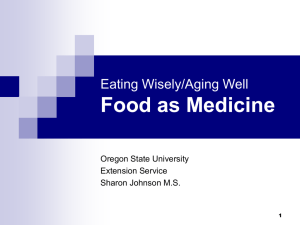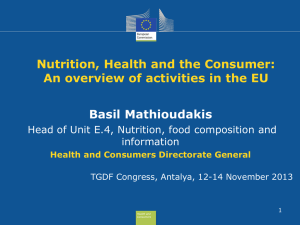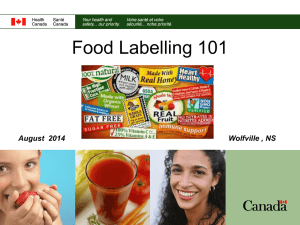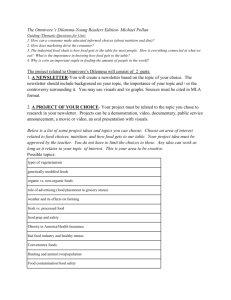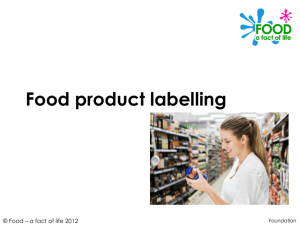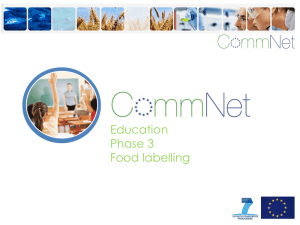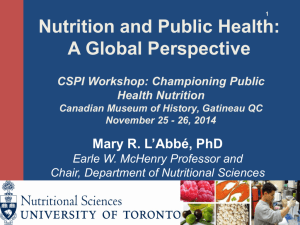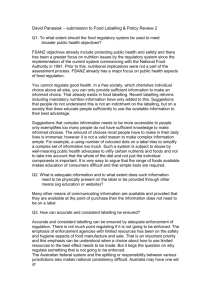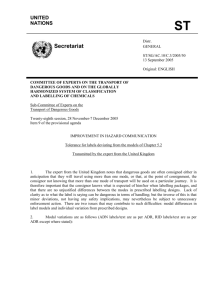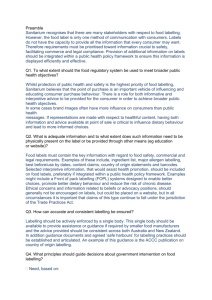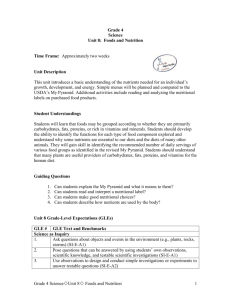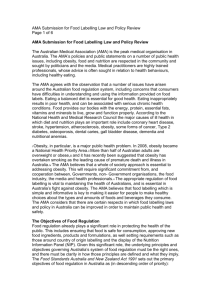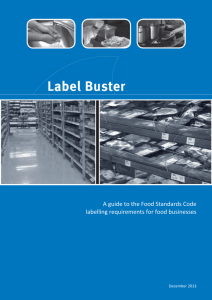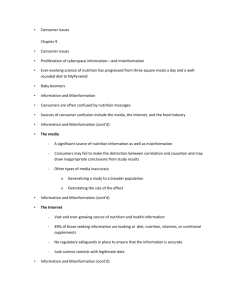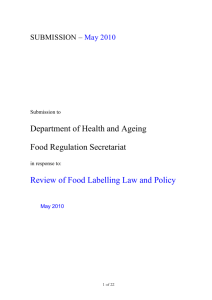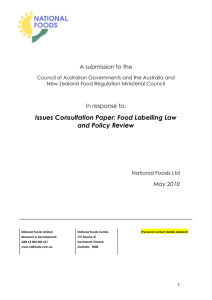Monday March 12 th - Memory Lane Family Place
advertisement
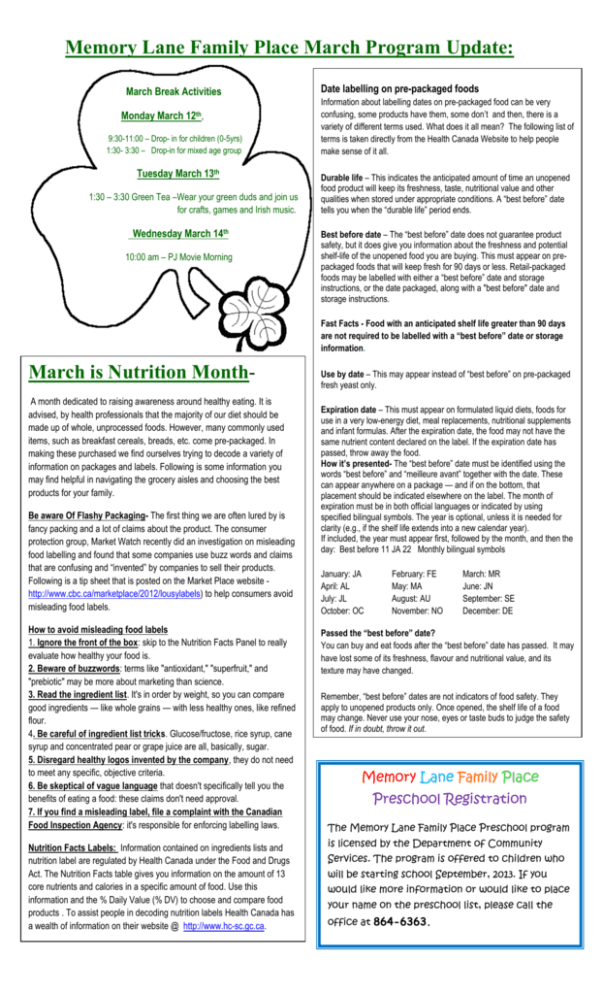
Memory Lane Family Place March Program Update: March Break Activities Monday March 12th, 9:30-11:00 – Drop- in for children (0-5yrs) 1:30- 3:30 – Drop-in for mixed age group Tuesday March 13th 1:30 – 3:30 Green Tea –Wear your green duds and join us for crafts, games and Irish music. Wednesday March 14th 10:00 am – PJ Movie Morning Date labelling on pre-packaged foods Information about labelling dates on pre-packaged food can be very confusing, some products have them, some don’t and then, there is a variety of different terms used. What does it all mean? The following list of terms is taken directly from the Health Canada Website to help people make sense of it all. Durable life – This indicates the anticipated amount of time an unopened food product will keep its freshness, taste, nutritional value and other qualities when stored under appropriate conditions. A “best before” date tells you when the “durable life” period ends. Best before date – The “best before” date does not guarantee product safety, but it does give you information about the freshness and potential shelf-life of the unopened food you are buying. This must appear on prepackaged foods that will keep fresh for 90 days or less. Retail-packaged foods may be labelled with either a “best before” date and storage instructions, or the date packaged, along with a "best before" date and storage instructions. Fast Facts - Food with an anticipated shelf life greater than 90 days are not required to be labelled with a “best before” date or storage information. March is Nutrition MonthA month dedicated to raising awareness around healthy eating. It is advised, by health professionals that the majority of our diet should be made up of whole, unprocessed foods. However, many commonly used items, such as breakfast cereals, breads, etc. come pre-packaged. In making these purchased we find ourselves trying to decode a variety of information on packages and labels. Following is some information you may find helpful in navigating the grocery aisles and choosing the best products for your family. Be aware Of Flashy Packaging- The first thing we are often lured by is fancy packing and a lot of claims about the product. The consumer protection group, Market Watch recently did an investigation on misleading food labelling and found that some companies use buzz words and claims that are confusing and “invented” by companies to sell their products. Following is a tip sheet that is posted on the Market Place website http://www.cbc.ca/marketplace/2012/lousylabels) to help consumers avoid misleading food labels. How to avoid misleading food labels 1. Ignore the front of the box: skip to the Nutrition Facts Panel to really evaluate how healthy your food is. 2. Beware of buzzwords: terms like "antioxidant," "superfruit," and "prebiotic" may be more about marketing than science. 3. Read the ingredient list. It's in order by weight, so you can compare good ingredients — like whole grains — with less healthy ones, like refined flour. 4. Be careful of ingredient list tricks. Glucose/fructose, rice syrup, cane syrup and concentrated pear or grape juice are all, basically, sugar. 5. Disregard healthy logos invented by the company, they do not need to meet any specific, objective criteria. 6. Be skeptical of vague language that doesn't specifically tell you the benefits of eating a food: these claims don't need approval. 7. If you find a misleading label, file a complaint with the Canadian Food Inspection Agency: it's responsible for enforcing labelling laws. Nutrition Facts Labels: Information contained on ingredients lists and nutrition label are regulated by Health Canada under the Food and Drugs Act. The Nutrition Facts table gives you information on the amount of 13 core nutrients and calories in a specific amount of food. Use this information and the % Daily Value (% DV) to choose and compare food products . To assist people in decoding nutrition labels Health Canada has a wealth of information on their website @ http://www.hc-sc.gc.ca. Use by date – This may appear instead of “best before” on pre-packaged fresh yeast only. Expiration date – This must appear on formulated liquid diets, foods for use in a very low-energy diet, meal replacements, nutritional supplements and infant formulas. After the expiration date, the food may not have the same nutrient content declared on the label. If the expiration date has passed, throw away the food. How it’s presented- The “best before” date must be identified using the words “best before” and “meilleure avant” together with the date. These can appear anywhere on a package — and if on the bottom, that placement should be indicated elsewhere on the label. The month of expiration must be in both official languages or indicated by using specified bilingual symbols. The year is optional, unless it is needed for clarity (e.g., if the shelf life extends into a new calendar year). If included, the year must appear first, followed by the month, and then the day: Best before 11 JA 22 Monthly bilingual symbols January: JA April: AL July: JL October: OC February: FE May: MA August: AU November: NO March: MR June: JN September: SE December: DE Passed the “best before” date? You can buy and eat foods after the “best before” date has passed. It may have lost some of its freshness, flavour and nutritional value, and its texture may have changed. Remember, “best before” dates are not indicators of food safety. They apply to unopened products only. Once opened, the shelf life of a food may change. Never use your nose, eyes or taste buds to judge the safety of food. If in doubt, throw it out. Memory Lane Family Place Preschool Registration The Memory Lane Family Place Preschool program is licensed by the Department of Community Services. The program is offered to children who will be starting school September, 2013. If you would like more information or would like to place your name on the preschool list, please call the office at 864-6363.
